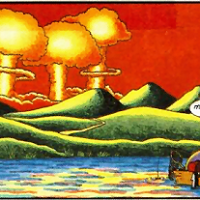 My voracious reading habit has deep roots in libraries. The love of reading comes from my parents, but libraries provided a vast smörgåsbord to browse and consume. Each week I’d check out as many books as I could carry. I discovered science fiction in a library (the Lucky Starr series, with Isaac Asimov writing as Paul French, is the first I remember).
My voracious reading habit has deep roots in libraries. The love of reading comes from my parents, but libraries provided a vast smörgåsbord to browse and consume. Each week I’d check out as many books as I could carry. I discovered science fiction in a library (the Lucky Starr series, with Isaac Asimov writing as Paul French, is the first I remember).
Modern adult life, I got out of the habit of libraries (and into book stores and now online books). But now the Cloud Library has reinvigorated my love of all those free books, especially the ones I missed along the way.
For instance, Farewell to Reality: How Modern Physics Has Betrayed the Search for Scientific Truth (2014), by Jim Baggott.
Let me start by saying I’m a fan of Baggott’s work. I’ve seen a couple of talks he’s given, read a couple of his articles, and now this book. I’ve enjoyed them all. I think he and I have similar views on many (even most) points.
Baggott, who has a PhD in chemical physics, is a science writer who has written about the discovery of the Higgs boson as well as other books about quantum physics (including one intended for college students of quantum theory).
§
In Farewell to Reality Baggott joins Lee Smolin, Peter Woit, Sabine Hossenfelder, and too few others, in making some very pointed observations about how modern physics has blurred the line between fact and flights of fancy.
Theoretical physics, higher mathematics, and philosophy, all share a trait that lends itself to such flights: they all are a form of storytelling, of fiction. They are products of our imagination.
Often fiction turns to fact, and many physical and mathematical “fictions” have eventually become fact. Others have not, but such fictions tend to be open-ended: we may discover, at any time, something that makes them fact.
Also, it’s important to never step on creativity and imagination. Those are crucial to leading us in new directions. At the same time, we need to be careful about distinguishing what is factual and what is fanciful.
This is exactly the point of Baggott’s book.
§
The book divides into two parts: The Authorized View and The Grand Delusion.
Prior to those is a single chapter that frames his thesis: The Supreme Task: Reality, Truth and the Scientific Method. He begins that chapter (and the book) with:
Now I want to be absolutely clear and unequivocal upfront. I trained as a scientist, and although I no longer practise, I continue to believe — deeply and sincerely — that only science, correctly applied, can provide a sure path to true knowledge of the real world.
Implicit in this opening statement is that Baggott is a realist: he believes in the real world external to us. In fact, he will make much of the Copernican principle, which essentially says we humans are just incidental to reality.
This opening chapter is, in fact, an explicit statement of scientific realism, and Baggott introduces six principles:
- The Reality principle: the assumption that, while we can never truly know it in its entirety, reality exists “objectively and independently”, and is “rational, predictable and accessible to human reason.”
- The Fact principle: Facts are real, but are never theory-neutral. All observation and experiment has “a supporting theory of some kind.”
- The Theory principle: “The process of abstraction from facts to theories is highly complex, intuitive and not subject to simple, universal rules.” Any approach is valid if it produces a theory that works.
- The Testability principle: A theory must provide some way of testing it. Canonically we use falsification, but a failed test doesn’t always mean a theory is bad — sometimes the test is bad.
- The Veracity principle: No theory is ever proved with certainty. But over time, when a theory survives all tests and analysis, it becomes accepted as a contingent version of reality, a provisional ‘truth.’
- The Copernican principle: We humans are not the center of the picture. The universe, in no sense, exists for us.
He asks that the reader keep these in mind as he explores, firstly, what he calls the “authorized” version of physics (the theories we’ve come to take as provisional truths), and secondly, what he calls “fairy tale” physics.
§
In the first section, The Authorized Version, Baggott spends five chapters exploring exactly what that is.
He covers photons & quantum theory; the Standard Model, matter & mass; Special & General Relativity; dark matter & dark energy; the Big Bang & inflation.
Along the way he points out many of the gaps in these theories and reminds us they are contingent truth — theories that do a very good job of predicting outcomes. Some of our theories do an extremely good job of predicting — the theoretical numbers match what we measure to high precision.
In the last chapter of the section, What’s Wrong with this Picture?: Why the Authorized Version of Reality Can’t be Right, Baggott focuses on how we know our theories are, at best, incomplete.
In fact, the two greatest theories, Relativity and Quantum Mechanics, are in direct conflict with each other. And while we’re pretty sure there is something behind what we label as dark matter and dark energy, we have no idea what it is.
So on the one hand we have powerful and accurate theories, but on the other hand we don’t quite know how to fit the pieces together. We don’t even know for sure if that’s because the pieces aren’t right or because we don’t yet see the big picture. We do know some pieces are missing.
This authorized version, effective as it is, leaves us wanting more.
As Baggott writes:
The current authorized version of reality consists of a collection of partially connected theoretical structures — quantum theory, the standard model of particle physics, the special and general theories of relativity and the ΛCDM model of big bang cosmology. There remain many significant problems with these structures and we know this can’t be the final story. But there is little guidance available from experiment and observation.
§
The Yin to the Yang is the second part, The Grand Delusion.
The thing about theories is that you never know. Even the wildest theory might turn out to be correct. But many don’t.
Baggott’s point is that, in the light shone by his six principles, absent any testable predictions, we must classify as “fairy tale” physics many ideas science currently takes a little too seriously.
Here Baggott spends five chapters exploring: Supersymmetry & GUT; string theory & TOE; multiverses & the MWI; quantum information, black holes & the holographic principle; the Anthropic argument.
A sixth chapter echoes the very first chapter and presents six questions that he guesses readers might ask:
- If fairy-tale physics isn’t science, what is it?
- But aren’t theoretical physicists supposed to be really smart people?
- Okay, but in the grand scheme of things is there any real harm done?
- What do philosophers have to say about all this?
- Are we witnessing the end of physics?
- So, what do you want me to do about it?
The very last sentence of the book sums it all up:
Come to your own conclusions.
§
I thoroughly enjoyed the book, but especially the second part because I seem to make the same cut between fact and fancy he does.
I think the reality is that any reasonable analysis of these theories should make that cut. It’s actually not at all subtle or difficult. In fact, it’s tragic that we’re taking these fairy tales so seriously.
The thing is, it’s easy to lose one’s way when it comes to ideas without factual grounding. (Sabine Hossenfelder’s book about this is called Lost in Math.)
Philosophy has always wandered freely through preposterous territory. Theoretical physics has much in common with philosophy on that point.
I, too, have big issues with the topics in Part II, so it’s nice to hear another voice saying so. Superstrings and supersymmetry are bad enough, but multiverses and MWI are (to my eye) absurd.
I also have some big issues with the Anthropic argument, which is in opposition to the Copernican Principle, but that’s a whole other post (and don’t even get me started on the Doomsday argument).
That said, I do think human intelligence might be a case where the Copernican Principle fails. Our existence might, indeed, be objectively special (that is to say rare).
§
Baggott emphasizes a point I think worth remembering: Often the storytellers of these fairy tales appeal to how, in the past, our intuitions proved wrong, so therefore our intuition that their fairy tale is pure bullshit is probably wrong, too.
But in those past cases it was evidence or irrefutable argument that changed our intuition. In the absence of that support, we should continue to (provisionally) trust our intuition.
Baggott, like Einstein (and me, too), is a realist who believes reality is rational and makes sense. When our theories don’t makes sense, in the absence of supporting facts, we should apply some salt.
Stay away from fairy tales, my friends!
∇













April 9th, 2020 at 10:08 am
Walking into a library I still feel the same vague sense of entering a sacred place as I do when I’m in a church. I think it has something to do with a sense of sacrosanct purpose. Libraries are how we remember, how we explore who we are, and how we learn about the world and others.
So, yeah, pretty sacred places.
April 9th, 2020 at 1:46 pm
It’s been several years since I read ‘Farewell to Reality’. I recall mostly agreeing with it, but with some caveats.
For one, I think the name, “The Authorized Version of Reality” is awful. (And said so in my own review of it back then.) It implies some kind of authoritarian council somewhere who’s made decisions about it, rather than the long term pragmatic predictive reliability some theories attain. Baggot himself seems to have moved away from this labeling, which I think is good.
I also think, and this is somewhat colored by his tweets over the years, Baggott can be intolerant of legitimate scientific speculation. I wonder what his attitude might have been toward Copernicus’ theory in 1550, when there was no way to test it over the Ptolemaic system. Or the EPR (Einstein–Podolsky–Rosen) paper in 1935, which many derided as pointless metaphysical speculation, until decades later John Stewart Bell figured out a way to test it. What is metaphysical speculation today may be science a generation or century later.
All of which is to say, the line isn’t sharp and bright, but broad and blurry. Where we get into trouble, I think, is when we forget the epistemic status of a theory. Speculation is fine, but acceptance without empirical evidence isn’t. My issue with Baggott, is he often seems opposed to even the speculation.
April 9th, 2020 at 3:40 pm
I can’t say I have any issues with his use of “Authorized” — I see it as just a literary metaphor. The phrase “the authorized X” is authorized, so to speak. 🙂
It’s not that he ever suggests anything about authority (quite the opposite, really), and very early in the book (page 10), he writes, “But we have to accept that even in this ‘official’ or ‘authorized’ version of reality there are many grey areas,…” The ticks around both words, and their binding together, suggests to me that he does mean those words with some irony, and it’s the first time he uses the word in the text.
I don’t think he (or I) takes the word as seriously as you might? (Maybe I’ve just seen it used ironically so many times I just figured this was likewise.)
I’m not on Twitter so I can’t speak to what he has said there. He does seem disdainful of taking some kinds of speculation too seriously, of not clearly marking it as speculation. His concern, which is well founded, involves a horror at the very idea of “post-empirical science” — something that should be an oxymoron.
It’s fine to cherry pick examples of far-sighted scientists (it turns out many of them were right for the wrong reasons), but they don’t stack up to all the crackpots. No theory has a right to be taken seriously without hard evidence or very strong argument.
“Where we get into trouble, I think, is when we forget the epistemic status of a theory. Speculation is fine, but acceptance without empirical evidence isn’t.”
That is exactly the point of his book. It’s reflected in his six principles.
I don’t read him at all as opposed to speculation. I do think he’s avid about labeling it correctly and very opposed to any notion of “post-empirical science” — something that some, including Sean Carroll, have explicitly pushed.
I can well understand he might get testy about those who promote such ideas.
April 24th, 2020 at 1:49 pm
In what seems an ironic jump, now I’m reading Our Mathematical Universe by Max Tegmark. Especially after reading Baggott’s book, I’m finding myself bogged down in Tegmark’s evangelicalism. (He’s like Brian Greene that way. Or Sean Carroll these days, for that matter.)
I’ve never been a fan of his MUH, but what’s set me off (after a good start) is how he posits eternal inflation as nearly a given (thus enabling his Type I and Type II multiverses).
Inflation isn’t a given, although the evidence is pretty strong for it. But eternal inflation? That’s more into Baggott’s Fairy Tale physics.
April 25th, 2020 at 12:15 pm
And Tegmark is just as embracing of MWI as one would expect given he believes everything is mathematics. That’s about the one view where MWI actually makes sense. (I’ve long said that a belief in MWI amounts to a belief in a Tegmarkian universe.)
He never goes near the energy question, and his attempt to explain the probability problem just confirms my impression it’s a real problem. (Tegmark apparently is the guy who came up with the idea of Quantum Suicide.) Simply put, in any series of weighted probability tests, the 1-1-1…1-1-1 and 0-0-0…0-0-0 branches must actually happen to someone. But if reality doesn’t branch, then the odds of those outcomes remains an outside possibility that almost never actually happens.
So a simple question is: Do we really live in a universe where everything possible happens or in a universe were usually the most likely things happen and sometimes odd things happen?
Sure it’s an intuition (versus another intuition), but where is the evidence to believe otherwise? So far all the evidence points to a single reality.
December 31st, 2020 at 7:59 am
[…] very much enjoyed Jim Baggott’s book about fairy tale physics as well as Philip Ball’s book about quantum mechanics interpretations. Both books concerned […]
March 21st, 2022 at 1:05 pm
[…] grounded approach to physics, and we share that we’re both committed to metaphysical realism. Almost two years ago, I posted about his 2014 book Farewell to Reality: How Modern Physics Has Betrayed the Search for […]
January 17th, 2024 at 4:01 pm
[…] Fairy Tale Physics (85) […]
March 1st, 2024 at 2:23 pm
[…] and have written many times here about fantasy and science fiction in science. [See, for instance, Fairy Tale Physics, Our BS Culture, and Our Fertile Imagination for just a few […]